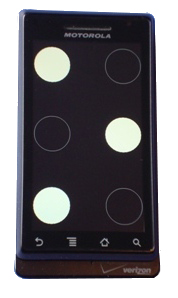V-BRAILLE (accessibility app)
UX in the Wild - Aug. 29, 2012: Seattle WA
Today I met with Richard Ladner, Professor in Computer Science and Engineering at the University of Washington. The interview was regarding a project he is leading – a touch screen game for blind children to learn braille. The product is called, V-Braille.
V-Braille is touch screen game for the blind to learn braille. It’s targeted to children, although a small percentage of blind people read braille (about 10%). The website describes V-Braille as, “…an infrastructure for smart phones that employs vibration as the means for reading Braille. Additionally, it uses both vibration and text-to-speech for entering (or “writing”) Braille. Using this infrastructure, the V-Braille research project* is currently designing Braille-learning games that blind (and sighted) children can play on smart phones.”
V-Braille is one of a list of accessibility projects at the UW. Here are a few:
- Color Namer is a program which allows the user to determine the color of an object, by pointing the phone’s camera at it and tapping the screen.
- ezTasker is to assist people with cognitive disabilities through daily activities with visual and audio aid.
- Mobile OCR uses a powerful optical character recognition (OCR) engine to provide low vision and blind individuals with a way to read printed text on the go. The user is completely guided through tactile and audio feedback.
- The PortraitFramer app uses face detection on mainstream smartphones to provide alternate and non-visual modes of feedback and interaction while the user takes a picture.
- Talking Calculator is a non-visual calculator using the touchscreen and audio feedback.
- And the app I use and love, One Bus Away.
Sadly, people with disabilities are not supported in mainstream media creation. This is a bottom line decision because that audience represents too small a number to get noticed. Through my work with various design and technology companies, I’ve helped create many rich, experiential, immersive media sites, and accessibility was never part of the business/design directive. We didn’t even utilize the alt tags. My goal is to help change that. Thanks to the many dedicated professionals like Professor Richard Ladner who are championing a worthy cause.
More on this topic to come.
